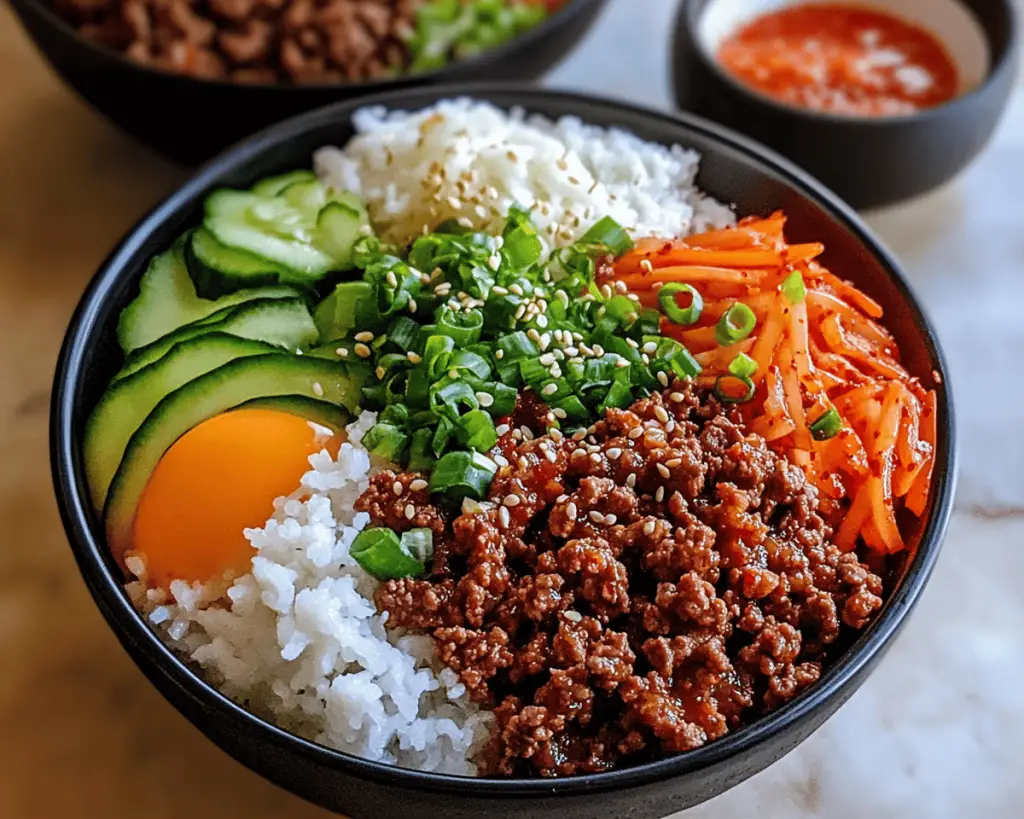You know how sometimes a recipe finds its way to you at just the right moment? That’s how it was with this **Korean Ground Beef Bowl**. I just happened to scroll through a food blog one lazy afternoon, and there it was—colors popping, flavors promising, and something about it whispered “comfort food.” It had all the makings of a quick weeknight dinner, but with a charm that made it feel special.
What really hooked me was the simplicity of it. I remember standing in my kitchen, looking at the ingredients on my countertop. I had an open package of ground beef and a few vegetables wilting in the fridge. Thanks to a handful of Korean-inspired seasonings, I could turn what felt like a mundane reminder of grocery shopping into something vibrant and delicious. Honestly, I was excited to bask in the warm, savory scents filling my kitchen, and it’s one of those dishes that seems to embody more than just its ingredients—it carries memories, emotions, and a dash of nostalgia.
This bowl has now become a go-to in my house. Whether it’s a busy weeknight or a cheerful weekend gathering with friends, it never disappoints. Plus, the beauty is in its flexibility—you don’t have to follow it religiously. You can toss in whatever veggies you’ve got or tweak the sauce to suit your own tastes. The appreciation I have for recipes like this grows deeper every time I whip it up, so let’s dive into what makes this dish so special!
### What Goes Into Korean Ground Beef Bowl?
First things first—let’s break down the main players in this tasty ensemble. Each ingredient isn’t just there for show; they each bring something unique to the table (literally).
– **Ground Beef**: This is the backbone of the dish! I usually grab the lean stuff because, let’s be honest, no one wants an oil slick in their bowl. There’s a comforting heartiness to beef that grounds this dish, plus it cooks up quickly. If you’re feeling adventurous, you could even swap in ground turkey or tofu if you’re catering to dietary needs.
– **Soy Sauce**: Ah, the umami bomb! I generally prefer using **low-sodium soy sauce** because it lets the flavor shine without overwhelming saltiness. And if you want to feel fancy, consider a splash of **dark soy sauce**—it’ll intensify the color and add richness.
– **Brown Sugar**: Here’s the surprise ingredient that gives a sweet balance against the savory elements. I promise you, it’s like a warm hug in every bite. Just be careful not to go overboard; a couple tablespoons would do!
– **Sesame Oil**: If there’s one oil that instantly wraps me in a sense of coziness, it’s sesame oil. I mean, just a few drops and your kitchen smells like you’re in a bustling Korean eatery! Plus, that nutty flavor? Perfection. I pick the toasted kind for an extra punch.
– **Garlic and Ginger**: Fresh aromatic ingredients here! There’s something about chopping garlic that feels meditative to me. I usually hit the garlic hard and add a little ginger, too, because the sweet and spicy combo just works.
– **Green Onions**: These are often my go-to garnishing hero. They brighten things up with a pop of color and a little bite.
– **Vegetables**: Load them up! I vary these depending on the season or what’s rolling around the fridge—think bell peppers, broccoli, spinach, or even carrots. You really can’t go wrong.
– **Rice**: The base of the dish. Steamed, fluffy rice to soak up all those incredible flavors. I typically opt for jasmine or sushi rice because I love that sticky quality. But any rice can do the trick—you do you!
You really can’t mess this up. The ingredients are pretty flexible, and honestly, whatever you have kicking around can likely be thrown in here with success!
### Is Korean Ground Beef Bowl Actually Good for You?
Now, here comes the real talk. Is this bowl of deliciousness actually good for you? Let’s be transparent here. Yes, it’s a comfort food classic, and yes, it’s a tad indulgent. I mean, we’re working with ground beef and soy sauce here, so it’s not exactly a salad, you know?
That said, I love that, with the right adjustments, you can still enjoy the richness without feeling like you’re overdoing it. Here’s how I like to think about its nutritional components:
– **Protein**: Ground beef brings a solid amount of protein to the table, which is great for satisfying those hunger pangs. You can easily add more protein if you want by tossing in some beans or even adding an egg on top when serving.
– **Veggies**: Don’t skimp on the veggies! They should be a sizable portion of your bowl—think of them as adding color and health while cranking up the fiber content! This dish is a fantastic way to sneak those greens in, and you can always mix and match to your heart’s content.
– **Carbs**: Rice is a wonderful carrier of flavors, but you could swap it out for quinoa or brown rice if you want a little extra nutrition. Or you can try cauliflower rice if you’re watching your carbs.
So yes, while it’s comforting and indulgent, it can also be modified to fit a healthier profile depending on what you decide to throw in. It’s about balance, right? Plus, cooking at home means you can control all the good stuff.
### Here’s What You’ll Need
– **Ground Beef**: 1 pound, lean (or your preferred protein)
– **Soy Sauce**: ¼ cup, low-sodium
– **Brown Sugar**: 2 tablespoons
– **Sesame Oil**: 1 tablespoon (toasted preferred)
– **Garlic**: 4 cloves, minced
– **Ginger**: 1 tablespoon, grated (or more, if you’re like me and love ginger)
– **Green Onions**: 2, chopped (plus more for garnishing)
– **Vegetables**: 2 cups (bell peppers, broccoli, carrots—whatever you’ve got!)
– **Rice**: 2 cups, cooked (for serving)
You’re gonna want to play around with portions a bit, especially if you’re feeding a crowd, but this should get you started nicely!
### How to Make Korean Ground Beef Bowl Step-by-Step
Alright, let’s get down to the nitty-gritty of making this beauty.
1. Start by cooking your rice as per the package instructions. While that’s going, you can tackle the rest—so efficient, right?
2. In a large skillet (get your biggest one ready), heat up a splash of sesame oil over medium-high heat. This is the time to dance a little; the oil should shimmer and sing.
3. Toss in your **ground beef**. Use a wooden spoon or spatula to break it up as it cooks. Here’s the thing: you want it to brown nicely, so don’t rush this. Let it get golden and caramelly, about 5-7 minutes should do it.
4. Once it’s nice and brown, drain any excess fat (unless you like a little grease to the flavor, then go wild).
5. Now, add the minced **garlic** and grated **ginger**. You want to let them bloom for about a minute. The scents wafting through the kitchen will be almost intoxicating.
6. Next, pour in the **soy sauce** and add the **brown sugar**. Stir well to combine everything and let it bubble just a bit. This is where the magic happens!
7. Toss in your veggies! Stir fry until they’re vibrant and tender but not mushy. The color contrast is just so beautiful. It’s like a mini artwork in your pan.
8. At this point, your rice should be fluffy and waiting. Spoon some into bowls and top with that fabulous beef and veggie mixture.
9. Finally, sprinkle those chopped **green onions** on top for a final touch of freshness. Maybe even a few sesame seeds if you have them? They add a nice little crunch.
### Little Extras I’ve Learned Along the Way
Ah, here’s the fun part! Over the time I’ve made this dish, I’ve picked up a few tips and tricks that I can’t keep to myself:
– **Add Egg**: If you want to make it a bit more indulgent, fry up an egg sunny-side up and place it on top of each bowl. It’s an absolute game changer!
– **Add a Kick**: You like it spicy? Add some sriracha or gochujang (Korean chili paste) while cooking. I promise, it adds a whole new level of depth to flavors.
– **Bye-Bye, Beef**: If you’re allergic to beef or simply don’t have any on hand, don’t fret! Ground chicken, turkey, or even lentils for a vegetarian/vegan take work just as brilliantly.
– **Leftovers are Gold**: This dish makes fantastic leftovers, especially for lunch the next day. Just reheat gently and voilà—you’ll be the envy of the break room.
– **Make-Ahead Friendly**: You can prep everything the night before, and then when it’s time to eat, just cook that rice, heat up the skillet, and you’ll have dinner on the table in a flash!
This one means a lot to me. Every time I plunk down a bowl filled with all those layers of flavors, it reminds me of the joy of cooking, of improvisation, and sharing food that feels like home. I hope you give it a try and maybe even put your spin on it—I’d love to hear what you come up with! Let me know if you try it—I’d love to hear your twist. Happy cooking!



